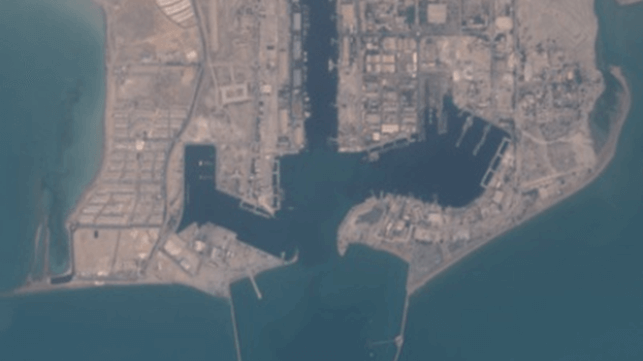Iranian Warships and Tankers Disperse in Anticipation of Attack

Sentinel-2 satellite imagery of Iranian naval bases indicates that that the majority of Islamic Republic of Iran Navy (Nedaja) and Islamic Revolutionary Guard Corps’ Navy (Nedsa) vessels have left their berths, and are either at nearby anchorages or have deployed further afield. The Kharg island oil terminal has also been cleared of empty VLCC supertankers, although tankers are continuing to load.
The heightened alert is also reflected in the air: residents of Tehran have complained of being kept awake at night by the constant sound of Iranian fighter aircraft overhead, and airspace has been closed to civilian traffic.
Radar-based satellite imagery shows Iranian tankers are no longer anchored near Kharg Island's oil terminal.
— Brady Africk (@bradyafr) October 3, 2024
This facility handles 90% of Iran's crude oil exports. pic.twitter.com/SCLAtNvlmQ
Tankers vacate the anchorage at Kharg Island
Bandar Abbas is Iran’s principal naval base and the headquarters of the Southern Fleet’s 1st Naval Region. Nedaja vessels assigned to the Bandar Abbas naval base tend to have a home pier, which appears to be allocated to a particular class of ship, if not to particular vessels. Even with medium resolution imagery therefore it is possible to ascertain what type of ships have deployed or have been moved out of port for safety.
Two Kilo Class submarines are no longer at their normal berth, though only one of these submarines is believed to be operational. The third Kilo Class submarine is out of the water and under repair. The same pier is also usually host to about six Ghadir coastal submarines, and these are all apparently absent.
The wharf that normally hosts Alvand and Moudge Class frigates still has two ships alongside, but the wharf for the two Bayandor corvettes, IRINS Bayandor (F81) and IRINS Naghdi (F82) is empty. Some reports suggest that IRINS Dena (F75) is currently the flagship of the Nedaja flotilla permanently on station in the Bab el Mandeb area, and this flotilla may have been reinforced by some of the other ships now missing from Bandar Abbas.
The pier that normally hosts up to nine French-built Kaman and Sina Class fast attack craft - equipped with C-802 anti-shipping missiles - is completely empty.
IRINS Tunb (L513) and IRINS Lavan (L514) - two logistics and drone-launch ships which are critical to the Nedaja’s capability to carry out distant deployments - are also absent, as are up to three Delvar Class auxiliaries. These ships are likely to be committed to supporting Nedaja ships that have deployed out of port to safe anchorages or on operational patrols. This role can also be performed by IRINS Makran (K441), which is also absent from its normal berth on a pier in the naval base’s outer basin.
It is not possible to identify the three ships of India’s 1st Training Squadron as being present in the basin. These ships had been escorted into Bandar Abbas on September 30 by the Sina Class IRINS Zereh (P235). Similar Training Squadron visits in the past have lasted three days.
Ships from the IRGC’s Nedsa use the western side of the Bandar Abbas naval port. The distinctive Shahid Soleimani Class catamaran missile corvettes normally present were absent on 4 October, as was the logistic ship Shahid Roudaki (L110-1).
Nedaja berths at the naval port in Chah Bahar observed on 3 September, which normally hosts a frigate and some fast attack craft, also appear to be empty. Jask, which usually has a pair of Ghadir Class submarines and up to five Kaman Class fast attack craft moored on the outer harbor mole, was observed on October 1; from poor resolution imagery, only two Kaman Class boats appear to remain in port.
In similar fashion, ships of the Northern Fleet responsible for the Caspian Sea have also left port; identifiable on social media, the Sina Class fast attack craft IRINS Joshan (P225) was one of the vessels seen leaving Bandar Anzali.
Some of the vessels which have left port were non-operational or undergoing refit. Such vessels are likely to be laid up in anchorages nearby. But most of the out-of-port deployments will be to pre-planned mobilization positions, on tasks to frustrate expected attacks or to deliver retaliatory action.
The Iranian leadership has already warned Gulf States not to facilitate any attacks on Iran, a message delivered publically but also by Iranian President Masoud Pezeshkian on his visit to Qatar on October 2. The next day, Crown Prince Khaled bin Mohammed from the UAE visited Doha, presumably to be briefed on the Iranian messaging, which is likely to have included threats by Iran to target GCC countries should they ignore the warning. Iran’s naval deployments should be seen in this context, and there is clearly a heightened risk of shipping interdiction in the Straits of Hormuz.
